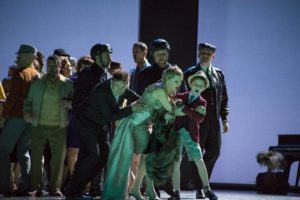Student Review: Dense but Rewarding: The Metropolitan Opera’s The Exterminating Angel

The Exterminating Angel
Kellie MacDonald from the Theatre Criticism course of Patrick Langston, U of Ottawa
Widely considered the opera event of the season, this is the North American premiere of acclaimed British composer-conductor Thomas Adès’s newest work. With direction and libretto by Tom Cairns, The Exterminating Angel draws inspiration from the 1962 Luis Buñuel film of the same name. It is, at the same time, thrilling and torturously slow, depicting the descent into madness of a Sartrean dinner party nobody can leave.
The Exterminating Angel features an expansive cast with over a dozen principal roles. As the stunning soprano diva Leticia Maynar, Audrey Luna reaches astonishing heights, singing the highest note ever heard on the Metropolitan Opera stage (an A above high C). Other notable performances among the star-studded cast include soprano Sally Matthews and countertenor Iestyn Davies as the codependent de Ávila siblings, and Sir John Tomlinson as the doctor, Conde. The piece, however, is truly tour-de-force of ensemble work. As a live-streaming event, the camera mediates the viewer’s experience, providing a front row view of the production. The detraction, however, is that close-ups on one or two characters at a time exclude the highly detailed expressions and gestures of the ensemble cast.
Musically, The Exterminating Angel is incredible in its dense yet nimble composition. Inspired by the minimalist sound design of Buñuel’s film, the piece opens with the ominous tolling of church bells. From there out, the score is anything but minimalist. Tension is heightened with the repetitive beat of marching drums, as if to signal a forthcoming war. Other unconventional instrumentation includes a passage played on 1/32 size violins. Cynthia Miller’s surreal ondes martenot — an instrument comparable to a early twentieth century electric keyboard — is dubbed by Adès “the ‘Exterminating Angel’ of the score”. The ondes martenot defies conventional description, but its ghostly presence within the score is distinct and undeniable.
Set and costume designer Hildegard Bechtler makes her artistic debut with the Metropolitan Opera on this production. Under Bechtler’s deft design, the women’s evening gowns and beehive hairstyles subtly evoke 1960’s Spain without coming across as too theatrical or overdone. It allows Buñuel’s criticism of the elite’s complicity in the face of fascist dictatorship to feel just as relevant to contemporary audiences as it did in the sixties. Thomas Adès’s The Exterminating Angel is a searing indictment of upper class depravity and self-involvement. This indictment, however, is delivered by a medium increasingly stratified by wealth and class. If one wishes to attend The Exterminating Angel live at the Metropolitan Opera, a ticket will run between $185 to $630 CAD. The Met has countered this division with offers of cinema screenings, student pricing, and rush tickets, but one wonders whether the production’s core message resonates with the majority of the audience.
Kellie MacDonald. Photo Emon Hassan